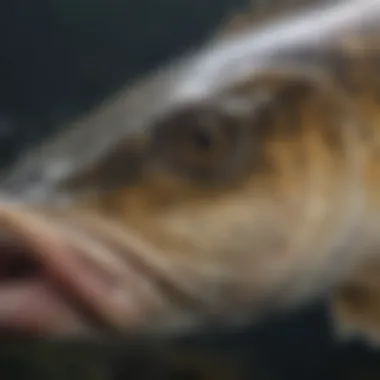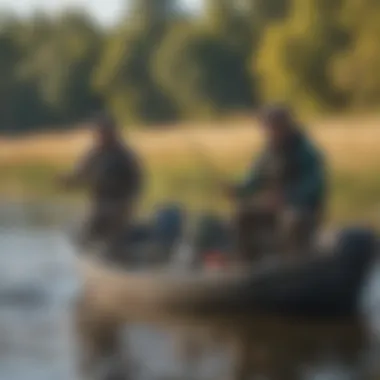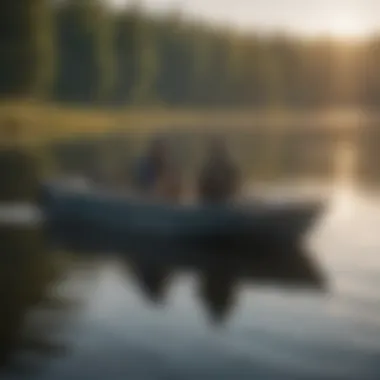Comprehensive Guide to South Dakota Walleye Fishing Season


Intro
Walleye fishing in South Dakota is more than just a pastime; it is a key component of the state’s recreational culture and local economy. Understanding the walleye season is essential for anglers, conservationists, and residents who depend on this resource. The significance of walleye extends beyond the fishing line; they play a vital role in the ecosystem and local communities. In this guide, we will delve into various aspects of the walleye fishing season, including compelling facts about the fish, behavioral traits, the latest scientific insights, and cultural relevance surrounding this species.
Fascinating Facts About the Animal
Walleye, known scientifically as Sander vitreus, are distinctive fish native to North America. They are recognized for their unique physical features and considerable adaptability.
Unique Characteristics
Walleye are characterized by their elongated bodies, sharp teeth, and a large mouth, which helps them capture prey. Their most striking feature is their reflective eyes which enable them to hunt effectively in low light conditions. In fact, their eyes can detect movements from long distances, adapting swiftly to varying light levels.
Extraordinary Abilities
Walleye have a remarkable ability to adjust to fluctuating environmental factors. They can thrive in both warm and cold water, although they generally prefer temperatures between 68°F to 72°F. This adaptability contributes to their prolific nature across various habitats, including rivers, lakes, and reservoirs. Their predatory instincts and ability to communicate through body language make them a fascinating species worth studying.
Behavior and Habitat
Understanding walleye behavior and their preferred habitats is crucial for successful fishing strategies.
Natural Habitats
Walleye are typically found in freshwater bodies, particularly in the northern United States and Canada. In South Dakota, they are commonly located in lakes like Lake Oahe and the Missouri River. These environments offer ample food sources and protection from predators. Spawning typically occurs in rocky areas when water temperatures reach 45°F to 55°F, usually in late March to early May.
Social Structures
Walleye tend to be solitary hunters, but they do form schools under certain conditions. Often seen grouped by size, social structures may change with environmental pressures. During spawning seasons, they aggregate in shallower waters, presenting an opportunity for anglers.
Recent Scientific Discoveries
Recent studies on walleye have led to significant discoveries about their biology and ecology.
Latest Research Findings
Research indicates that walleye exhibit complex behaviors when navigating their habitats. Findings suggest that they rely on environmental cues, such as temperature and light, to determine their movements. This helps scientists comprehend better their life cycles and breeding habits.
Breakthroughs in Animal Biology
Studies on walleye genetics have shown a diverse gene pool, which is essential for their adaptability. Understanding genetic variation plays a crucial role in conservation efforts and helps manage sustainable fishing practices.
Cultural Significance
Walleye hold a profound place in local culture, transcending mere recreation to embody community identity.
Animals in Folklore
In South Dakota, walleye have been part of local folklore for generations. They symbolize both sustenance and resilience, often featured in storytelling traditions among Native American tribes.
Influence on Art and Literature
Art and literature in South Dakota frequently reference walleye, reflecting fishermen's connection to nature. This fish is often portrayed in paintings and writings that celebrate the beauty and challenge of the sport.
Overview of Walleye Fishing in South Dakota


Walleye fishing in South Dakota represents more than just a recreational activity; it plays a pivotal role in the state's ecological and economic framework. Anglers across the region are drawn to this fish species, commonly known for its distinctive features and challenging catch. Understanding the walleye's place within local bodies of water provides insight into the broader aspects of aquatic life and biodiversity that influence fishing seasons and practices.
Importance of Walleye in Local Ecosystem
Walleye serves as a keystone species within South Dakota’s freshwater ecosystems. Its existence contributes to maintaining the balance of the local aquatic food web. As a predator, walleye preys on smaller fish such as yellow perch and minnows. This predation helps regulate fish populations, preventing any one species from becoming overly dominant.
Furthermore, walleye adaptation to different habitats supports their survival amid changing environments. Their spawning habits, often occurring in late spring, coincide with shifts in temperature and water levels, promoting a cycle of life that benefits the entire aquatic ecosystem. Healthy walleye populations can indicate good water quality, as they are sensitive to environmental changes. Protecting this fish aids in broader conservation efforts, preserving both the biodiversity of South Dakota’s lakes and rivers and the recreational opportunities for fishermen.
Historical Context of Walleye Fishing
Walleye fishing has a rich history in South Dakota, dating back to the era of Native American tribes who relied on this fish for sustenance. Over centuries, fishing techniques and habitat knowledge have advanced, allowing for more efficient and sustainable fishing practices.
In the mid-20th century, increased interest in recreational fishing led to the establishment of regulations to protect walleye populations. The state recognized the economic potential of walleye fishing, promoting tourism and local initiatives centered on this valuable fish species. Events such as walleye fishing tournaments have contributed not only to the local economy but also to a greater appreciation of fishing as a key aspect of South Dakota's cultural identity.
Alongside this, ongoing research and management efforts by wildlife organizations have aimed to monitor walleye populations, ensuring that fishing seasons remain sustainable for both the fish and the communities that depend on them. By focusing on a historical analysis of walleye fishing, it becomes clear that its significance extends beyond mere sport; it encompasses tradition, ecological balance, and economic vitality.
Walleye Fishing Season Dates
Understanding the Walleye Fishing Season Dates is crucial for anglers who want to maximize their fishing experience. These dates are not arbitrary; they are based on biological and ecological factors that help sustain walleye populations. Knowing when the season opens provides an opportunity to plan trips in advance, ensuring that fishing enthusiasts can take advantage of peak conditions. Additionally, adhering to these dates contributes to responsible fishing practices, which is essential for conservation efforts.
Opening Day of the Season
The opening day of the season varies each year, but it typically occurs in late May. This day marks the beginning of heightened fishing activity. Anglers are eager to cast their lines, hoping for a good catch after a long winter. The excitement around this day is palpable, drawing both novice and experienced fishermen. There are common practices on this day that help fishers succeed.
First, early morning hours are often when walleye are most active. Many anglers prefer to be on the water just before dawn. The excitement of the first catch adds to the overall experience, making it even more significant. Additionally, it is essential to check state regulations every year, as opening days may vary due to adjustments in management practices or local ecological needs.
Regulations Governing Walleye Fishing
The regulations that govern walleye fishing are vital for maintaining healthy fish populations and preserving the integrity of South Dakota's aquatic ecosystems. Regulations are not just legal frameworks; they serve as guidelines for responsible fishing practices. They are designed to ensure sustainable fishing while providing anglers with rules to follow. Understanding these norms contributes to the overall health of fish species, including walleye, and protects the natural environment. Anglers who abide by these regulations play a significant role in supporting conservation efforts.
Licensing Requirements
The licensing requirements for walleye fishing in South Dakota are straightforward but essential. An fishing license is mandatory for anyone aged 16 years or older. The state provides various license options, including daily, annual, and combination licenses that cover multiple species. Obtaining a license is not just about legality; it also supports conservation programs and helps manage fish populations effectively.
When purchasing a license, anglers must choose one that fits their fishing plans. For example, a daily license is suitable for those who fish occasionally, while an annual license is more cost-effective for regular anglers. Online purchases are possible, making it convenient to acquire licenses before hitting the water.
Size and Bag Limits
Size and bag limits are critical components of walleye regulations. These limits help control fish populations and ensure a balanced ecosystem. In South Dakota, the guidelines state that each angler can keep only a certain number of walleyes per day, and there may be specific size requirements as well.
The general limit for walleye is four fish per day, with one allowed at 20 inches or longer. Variation may occur due to local regulations or during specific seasons. Always check the latest regulations online before fishing.
These measures are imperative for protecting young fish, allowing them to grow and reproduce. Adhering to size and bag limits leads to improved fishing experiences over time, as larger and more plentiful fish become available. Responsible anglers contribute to the sustainability of walleye populations, ensuring that future generations can enjoy the same fishing opportunities.
By understanding and following these regulations, anglers not only comply with the law but also promote a healthy and fruitful fishing environment in South Dakota.
Essential Fishing Techniques
Essential fishing techniques are crucial for any angler aiming for success in walleye fishing. Employing effective methods can increase catch rates and enhance the overall fishing experience. Understanding these techniques can help both novice and experienced anglers make informed decisions on the water.
Best Practices for Catching Walleye
To effectively catch walleye, several best practices should be considered. First, understanding the walleye's feeding habits and habitat is essential. They are predatory fish that often prefer deeper waters during the day but migrate to shallower areas during dawn and dusk. Targeting these specific times can significantly improve the chances of a successful catch.
Using live bait such as minnows can attract walleye. Other effective baits include jigs and crankbaits. It is important to vary the retrieval speed and technique. Walleye can be quite picky, so trying different methods can make a big difference. Additionally, keeping noise to a minimum helps avoid spooking fish. Anglers should consider using soft or silent lures when fishing in shallow waters.


Choosing the right spots is also vital. Focus on areas with structures such as rocks, drop-offs, and submerged vegetation. Walleye often hide in these structures to ambush prey. Using fish finders can enhance location strategies, making it easier to identify productive areas.
The right timing, bait choice, and location can dramatically increase success in walleye fishing.
Recommended Gear and Tackle
Having the appropriate gear and tackle is fundamental for walleye fishing. Start with a good quality spinning or baitcasting rod between 6 to 7 feet in length. A medium-action rod is recommended, as it provides the versatility needed for various fishing conditions.
Selecting the right reel is equally important. A reel with a smooth drag system ensures easy retrieval and control of walleye during the fight. Line choice matters too; using a 10 to 15-pound test monofilament line is suitable, as it offers strength and sensitivity.
When it comes to tackle, jigs, crankbaits, and spinner rigs are top choices. Jigs can be paired with live bait or soft plastics for better effectiveness. Crankbaits are useful during active feeding periods, while spinner rigs can attract attention from walleye even in murky waters.
In summary, having the right techniques and gear is essential to enhance walleye fishing experiences. With practice and the application of these best practices and recommended gear, anglers can improve their chances of successful outings.
Top Locations for Walleye Fishing
Importance of Top Locations for Walleye Fishing
Identifying suitable locations for walleye fishing is critical for both recreational and commercial anglers in South Dakota. These locations offer not just abundant fishing opportunities but also enhance the experience of fishing by providing access to natural beauty and essential resources. In South Dakota, walleye are found in various bodies of water, from expansive lakes to winding rivers. What makes these locations especially significant is their capacity to support healthy walleye populations, which in turn benefits the local ecosystem and fishing communities.
In addition, knowing the top fishing spots can vastly accelerate the learning process for novice anglers. This knowledge allows them to adopt better strategies and increase their chances of successful catches, which leads to a more fulfilling fishing experience. Thus, this section aids in understanding both the geographical and ecological aspects that contribute to walleye fishing in South Dakota.
Popular Lakes and Rivers
South Dakota boasts several renowned lakes and rivers where walleye fishing thrives. Noteworthy among these are:
- Lake Oahe: Considered one of the best places for walleye fishing, Lake Oahe stretches over 600 miles. Its diverse habitats promote healthy populations of walleye. The northern part of the lake is particularly well-known for excellent fishing.
- Lake Francis Case: This lake offers numerous access points and outstanding catch rates. The submerged structures and weed beds attract walleye, making it a favorite spot for anglers.
- Missouri River: Flowing through South Dakota, the Missouri River has a wide range of fishing spots, particularly in its slower-moving sections where walleye congregate.
- Lake Sharpe: This reservoir has gained popularity for its consistent walleye action. The mix of shallow and deep water areas provides diverse fishing environments.
The choice of a fishing location can dictate the success of an outing. Experienced anglers often recommend these sites not only for their walleye populations but also for the overall fishing experience.
Access and Infrastructure
To maximize walleye fishing efforts, access to fishing locations and the infrastructure supporting these activities is paramount. Many of the top walleye fishing spots in South Dakota are equipped with well-maintained access points, including boat ramps and shore fishing areas. Here are some factors worth noting:
- Boat Ramps and Parking: Most popular fishing locales feature boat ramps suitable for launching various types of watercraft. Sufficient parking helps accommodate both small and large groups.
- Public Facilities: Adequate facilities such as restrooms and picnic areas enhance the fishing experience for families and groups. These elements encourage longer stays and contribute to local tourism.
- Regulatory Signage: Informative signage is often present to educate anglers on fishing regulations, conservation efforts, and the types of fish available in the area. Such information is vital for maintaining sustainable fishing practices.
- Nearby Amenities: Many fishing locations are located near towns that offer lodging, dining, and other services. This is advantageous for those planning extended fishing trips.
Overall, access to walleye fishing locations, along with the amenities and infrastructure available, plays an essential role in supporting both the activity itself and the culture surrounding fishing in South Dakota.
Impact of Climate on Walleye Fishing
The influence of climate on walleye fishing is a multifaceted issue that requires serious consideration. Walleye, a popular species among anglers, are sensitive to environmental changes. Walleye fishing in South Dakota is closely tied not only to regulations and location but also to climate. Understanding how climate affects the habits and availability of this fish can greatly enhance successful fishing experiences.
Seasonal Water Temperature Changes
Water temperature plays a significant role in the behavior of walleye. During the spring, as temperatures rise, walleye become more active. They spawn when the water temperature reaches around 45 to 55 degrees Fahrenheit. Anglers often target these fish during this time, recognizing the increased likelihood of catching them when they are hungry and mobile.
As summer approaches, water temperatures can climb significantly. Walleye tend to seek cooler, deeper waters during summer heat. It is crucial for anglers to adapt their strategies, often opting for night fishing or targeting submerged structures where walleye might congregate in search of cooler environments.
In the fall, as temperatures drop, walleye feed aggressively in preparation for winter. They often move to shallower waters. This behavior presents a good opportunity for anglers to capitalize on active feeding.
Weather Patterns and Fishing Success
Weather can also have a direct impact on walleye fishing. Specific conditions tend to produce better fishing results than others. For example, overcast days often yield higher success rates for anglers. The lack of bright sunlight allows walleye to swim more freely and hunt effectively. Conversely, extreme weather conditions, like thunderstorms, can lead to temporary shutdowns in walleye feeding patterns.
Additionally, fluctuations in barometric pressure can influence fish activity. Fish are often more active just before a cold front moves in. As the pressure rises after the front passes, walleye may become less inclined to bite.


Anglers should pay attention to both temperature and weather patterns to optimize their fishing experiences. Educating oneself about regular weather cycles can make a significant difference in the success of catching walleye in South Dakota.
Economic and Social Impact of Walleye Fishing
Walleye fishing plays a significant role in the economy of South Dakota. It not only supports local businesses but also provides jobs for residents. The impact can be observed in various sectors, including tourism, retail, and hospitality. An increase in fishing activity often correlates with a boost in economic contributions to areas that are popular for walleye fishing.
Contribution to Local Economies
Walleye fishing attracts thousands of anglers every year to South Dakota’s lakes and rivers. This influx is particularly prominent during the fishing season when businesses related to outdoor recreation experience higher customer engagement. Local economies benefit from the sale of fishing licenses, equipment, and bait.
Moreover, the tourism industry thrives due to walleye fishing. Hotels, restaurants, and guided tour services see an increase in revenue. In addition, various annual fishing events, like derbies and tournaments, not only enhance social interaction but also generate considerable economic activity.
The following details highlight the economic contributions:
- Increased spending in local shops and services,
- Enhanced job opportunities in fishing, hospitality, and recreation,
- Long-term benefits from tourism marketing and infrastructure development.
Community Events and Competitions
Community events and competitions centered around walleye fishing create strong social bonds among residents and visitors. These gatherings promote engagement and camaraderie within the community.
Fishing competitions can draw significant attendance and participants, which in turn stimulates local businesses. They often come with prizes, attracting not just the local fishermen but also those from neighboring states. In addition to economic benefits, these events foster a spirit of friendly competition.
A few notable aspects include:
- Development of community pride through local and regional competitions,
- Enhancement of relationships and networks among participants,
- Opportunities for educational programs about sustainable fishing practices and aquatic conservation.
“Community events based on walleye fishing showcase the unique culture of our region while supporting the local economy.”
Through these events, South Dakota emphasizes the importance of its natural resources, striking a balance between recreational enjoyment and environmental accountability.
Conservation Efforts and Sustainable Practices
Conservation efforts and sustainable practices are paramount for the long-term health of walleye populations and their habitats in South Dakota. Effective conservation strategies ensure that the state's natural resources can be enjoyed by future generations while maintaining biodiversity. Through responsible fishing practices, the ecosystem is able to thrive, benefiting not only walleye but other species within the habitat as well.
Importance of Conservation in Fishing
Healthy fish populations hinge on sustainable practices. The importance of conservation in fishing initiatives cannot be overstated. Overfishing, habitat destruction, and pollution pose serious threats to the stability of walleye populations. By emphasizing responsible fishing methods, such as adhering to size and bag limits, anglers can contribute positively to the ecosystem.
Benefits of Conservation
- Supports Biodiversity: Preserving the natural habitat fosters a diverse ecosystem that is resilient against environmental changes.
- Enhances Angling Experience: A sustainable walleye population ensures that anglers can continue to enjoy fishing for generations.
- Promotes Community Engagement: Conservation efforts often involve local communities, fostering a sense of stewardship towards natural resources.
Future of Walleye Fishing in South Dakota
The future of walleye fishing in South Dakota holds significant importance within the broader context of ecological health, local economies, and community engagement. As both a popular sport and a source of sustenance, understanding the trends and developments in walleye fishing can guide sustainable practices that preserve fish populations while ensuring enjoyable fishing experiences for future generations.
Trends and Predictions
Recent trends in walleye fishing indicate a complex interplay between environmental changes and angler ambitions. Climate change is one key factor likely to influence the future of walleye populations. Warmer water temperatures may alter fish migration patterns, spawning cycles, and overall population health. Forecasts suggest that as temperatures rise, some traditional fishing spots may become less productive, while new locations could emerge as hotspots.
Furthermore, technology is advancing rapidly in fishing gear and techniques. Innovations such as sonar fish finders and smart fishing apps are likely to enhance fishing success rates and improve the experience for anglers. These tools offer insights into fish behavior and habitat conditions, making it easier to locate and catch walleye.
Another element to consider is the shifting demographics of anglers. More families and recreational fishermen are participating in fishing activities, which may lead to increased pressure on walleye populations. Efforts to educate anglers on sustainable fishing practices will become critical in maintaining fish stocks. The trend towards catch-and-release fishing is also gaining traction, helping ensure better population management.
Ongoing Research and Development
Ongoing research in South Dakota plays a crucial role in supporting sustainable walleye fishing practices. Biologists and environmental scientists are studying the impacts of varied factors on walleye populations. For example, they are examining how changes in water quality and habitat affect growth rates and survival of young walleye. Studies also focus on the genetic diversity of the walleye population, which is vital for resilience against diseases and environmental shifts.
Innovative practices are being explored to enhance walleye habitats. Restoration projects, such as creating underwater structures or improving spawning areas, show promise for boosting population numbers. Local authorities are also developing policies that focus on balancing fishing interests with conservation. This includes maintaining bag limits and size restrictions to prevent overfishing.
In summary, the future of walleye fishing in South Dakota is shaped by a variety of factors, from climate changes to community engagement. By keeping an eye on trends and supporting ongoing research and development, stakeholders can better navigate the challenges and opportunities that lie ahead, ensuring the sustainability of this essential fishery.







